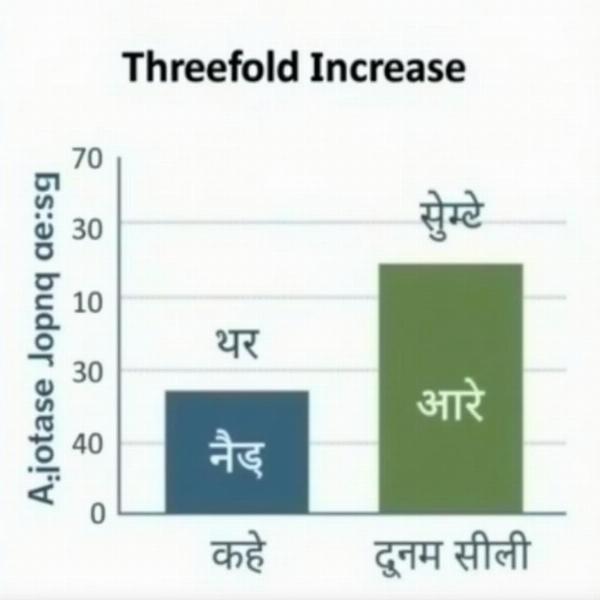Understanding the nuances of a word like “treble” in Hindi can be tricky due to its multiple meanings spanning music, general increase, and even electronics. This article will delve into the various Hindi translations and interpretations of “treble,” providing examples to clarify its usage in different contexts.
Understanding the Musical “Treble”
In music, “treble” refers to the higher end of the pitch range. The most common Hindi equivalent for this musical sense is तीव्र स्वर (teevra swar), which literally translates to “high-pitched sound” or “sharp note.” You might also hear ऊँचा स्वर (ooncha swar), simply meaning “high sound,” used in more casual conversations. For instance, a music teacher might say, “उस लड़की का तीव्र स्वर बहुत सुंदर है (Us ladki ka teevra swar bahut sundar hai)” – “That girl’s treble voice is very beautiful.”
Another term sometimes used, especially in the context of musical instruments, is तिगुना (tiguna), literally meaning “threefold.” This refers to the higher octave, reflecting the frequency relationships in musical scales. However, using “tiguna” can be ambiguous and is less precise than “teevra swar.”
Treble as an Increase
Beyond music, “treble” can also signify a threefold increase in quantity or size. Here, the most appropriate Hindi translation is तिगुना (tiguna). For example, “The company’s profits trebled in the last year” would translate to “कंपनी का मुनाफा पिछले साल तिगुना हो गया (Kampani ka munafa pichle saal tiguna ho gaya).”  Treble as Increase in Hindi You could also use तीन गुना (teen guna), literally “three times,” which serves the same purpose. Think of a shopkeeper saying, “इस साल दिवाली पर बिक्री तीन गुना हो गई (Is saal Diwali par bikri teen guna ho gayi)” – “Sales trebled during Diwali this year.”
Treble as Increase in Hindi You could also use तीन गुना (teen guna), literally “three times,” which serves the same purpose. Think of a shopkeeper saying, “इस साल दिवाली पर बिक्री तीन गुना हो गई (Is saal Diwali par bikri teen guna ho gayi)” – “Sales trebled during Diwali this year.”
Treble in Electronics
In the context of audio systems, “treble” refers to the high-frequency component of sound. While तीव्र स्वर (teevra swar) can be used here, उच्च आवृत्ति (uchch aavritti), meaning “high frequency,” is a more technically accurate term. For instance, someone adjusting their music player might say, “मुझे treble थोड़ा बढ़ाना है (Mujhe treble thoda badhana hai),” which could be translated as “मुझे उच्च आवृत्ति थोड़ा बढ़ानी है (Mujhe uchch aavritti thoda badhani hai)” – “I need to increase the treble a bit.”
Conclusion
Understanding the correct Hindi translation of “treble” depends heavily on the context. Whether you are discussing music, general increase, or audio settings, using the appropriate term ensures clear communication. Remember to consider the specific situation to choose between terms like तीव्र स्वर (teevra swar), तिगुना (tiguna), and उच्च आवृत्ति (uchch aavritti).
FAQ
- What is the most common Hindi word for “treble” in music? तीव्र स्वर (teevra swar) is the most common and accurate term.
- How do you say “treble” when talking about a threefold increase? तिगुना (tiguna) or तीन गुना (teen guna) are the most appropriate translations.
- What is the technical term for “treble” in electronics? उच्च आवृत्ति (uchch aavritti) is the technically correct term.
- Can I use “tiguna” for both musical and general increase contexts? While possible, using “teevra swar” for music and “tiguna” for general increase is clearer.
- Is there a difference between “teevra swar” and “ooncha swar”? “Teevra swar” is more specific to high pitch, while “ooncha swar” simply means “high sound.”
Suggested Further Reading
Meaning-Hindi.in is your trusted partner for high-quality Hindi translation services. We specialize in various fields, including business, legal, technical, website localization, and educational document translation. Our expert linguists ensure accurate and culturally sensitive translations for all your needs. Need a quick translation or specialized industry expertise? Contact us today! Email: [email protected], Phone: +91 11-4502-7584. Meaning-Hindi.in is here to help bridge the language gap.